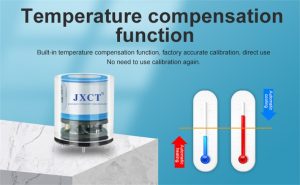Air pollution is a major environmental and health concern worldwide. It is caused by a variety of sources, including industrial emissions, vehicle exhaust, and agricultural activities. The pollutants released into the atmosphere can have serious health effects, including respiratory illnesses, cardiovascular diseases, and even cancer. While efforts to monitor and control air pollution have been ongoing for decades, there is still much that is unknown about the true extent of the problem. This is where gas sensors come in.

Gas sensors are devices that can detect and measure the concentration of specific gases in the air. They are widely used in industrial settings to monitor emissions and ensure compliance with environmental regulations. In recent years, however, there has been growing interest in using gas sensors to monitor air pollution in urban and rural areas. This has led to the development of new, portable sensors that can be deployed in a wide range of environments, providing real-time data on air quality.
The Role of Gas Sensors in Revealing Hidden Health Hazards
One of the key advantages of gas sensors is their ability to detect pollutants that are invisible to the naked eye. While we may be able to see and smell some types of air pollution, such as smoke or exhaust fumes, many harmful gases are odorless and colorless, making them difficult to detect without specialized equipment. Gas sensors can detect a wide range of pollutants, including nitrogen dioxide, sulfur dioxide, carbon monoxide, and volatile organic compounds. By measuring the concentration of these gases in the air, researchers and environmental agencies can gain a better understanding of the sources and distribution of air pollution, as well as its potential health effects.
Gas sensors are also valuable tools for identifying pollution "hotspots" in urban areas. Studies have shown that air quality can vary significantly from one location to another, even within the same city. By deploying gas sensors at multiple points throughout a city, researchers can create detailed maps of air pollution levels, helping to identify areas where intervention is most urgently needed. This information can be used to guide the development of targeted pollution control measures, such as traffic restrictions or the installation of air filtration systems in schools and hospitals.
In addition to monitoring outdoor air pollution, gas sensors can also be used to assess indoor air quality. Many people spend the majority of their time indoors, where they may be exposed to pollutants from sources such as cooking, cleaning products, and building materials. Poor indoor air quality has been linked to a range of health problems, including asthma, allergies, and respiratory infections. By using gas sensors to monitor indoor air quality, researchers can identify potential sources of pollution and develop strategies to reduce exposure.
Challenges and Opportunities
While gas sensors have the potential to revolutionize our understanding of air pollution, there are still several challenges that need to be addressed. One of the main challenges is the need for accurate and reliable sensors. Many of the existing gas sensors are not sensitive enough to detect low levels of pollutants, or they may be prone to interference from other gases in the environment. Researchers are working to develop new sensor technologies that are more selective and sensitive, as well as more affordable and easy to use.
Another challenge is the need for better data analysis and interpretation. Gas sensors can generate large amounts of data, and it can be difficult to make sense of this information without the right tools and expertise. Researchers are working to develop algorithms and models that can process and analyze sensor data in real time, providing valuable insights into the sources and dynamics of air pollution.
Despite these challenges, the use of gas sensors for air quality monitoring presents a number of exciting opportunities. For example, the development of low-cost, portable sensors has the potential to democratize air quality monitoring, allowing citizens and community groups to collect their own data and advocate for cleaner air. In addition, the integration of sensor data with other sources of information, such as weather data and satellite imagery, can provide a more comprehensive understanding of air pollution and its impacts.

Conclusion
Gas sensors have the potential to transform our understanding of air pollution and its health effects. By providing real-time, accurate data on pollutant levels, these sensors can help to identify pollution hotspots, track the effectiveness of pollution control measures, and guide efforts to protect public health. While there are still challenges to be addressed, the ongoing development of new sensor technologies and data analysis tools is paving the way for a more comprehensive and proactive approach to air quality monitoring. As we continue to unveil the hidden health hazards of air pollution, gas sensors will be essential tools for creating healthier, more sustainable communities.
 : +86 155 8830 2704
: +86 155 8830 2704 : jxdziot@gmail.com
: jxdziot@gmail.com
